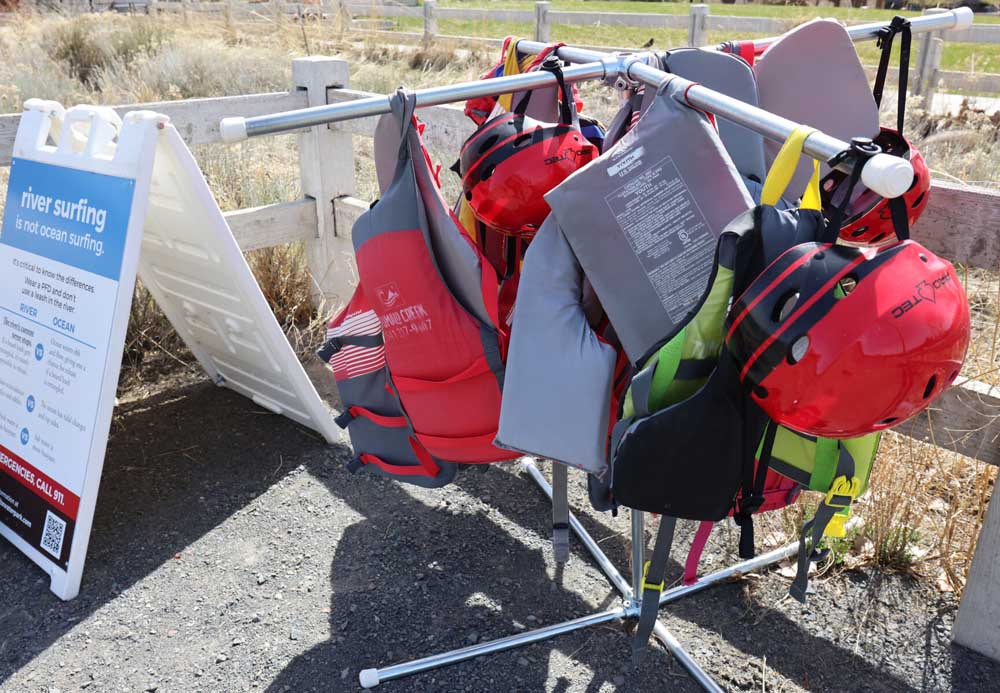Surfers reflect on one year anniversary of teen death at Bend whitewater park
Published 6:30 am Saturday, April 29, 2023

- Safety equipment is available at the Bend Whitewater Park on the Deschutes River in Bend.
BEND — One year ago at the Bend Whitewater Park in Bend, 17-year-old surfer Ben Murphy became entrapped in the standing wave and was held underwater for six minutes. He later died at St. Charles Bend.
The incident on April 30, 2022 has been seared into the memory of many surfers and park visitors and today a plaque by the wave pays tribute to Ben and helps the tight-knit community of surfers heal from that day.
Around the Whitewater Park, new signs and information boards offer tips on how to surf safely. New rules ban surf leashes on the wave, and there are helmets and floatation vests that can be borrowed at no cost.
But in the water, it’s the surfers themselves who are helping each other to stay safe on the wave.
On a recent sunny weekday, surfers were lined up on the rocks near the wave waiting for a chance to carve some turns. There were smiles all around and words of encouragement as each surfer entered the water.
“He’s always with us, especially when surfing,” said Austin Fernand, 21, an OSU-Cascades student and a regular in the surf wave lineup. “I love the memorial they put in. With Ben’s death, a lot of things have changed here for the better, which is really great.”
Stephen Bognar has been surfing at the park since late last year and speaks of a communal spirit at the wave where patience and support find a place at each surf session.
“The no leash rule, everyone is super respectful of it,” said Bognar. “There is an awesome sense of community; everyone is watching out for each other. That is one of the things I like most about the wave is this sense of community.”
Bognar says surfing in a river rapid is always going to come with some sense of risk but he adds that Bend Park & Recreation District, which manages the park, has done everything possible to mitigate the danger.
“You are on a surfboard in pretty fast rapids but as managing the risk I think they do the best they possibly can,” he said.
View the wave on The Bulletin’s webcam: Bend Whitewater Park
The park district advises river-goers to be vigilant of conditions in the river, which can change quickly. That advice goes out to not just surfers but also tubers, kayakers, and swimmers.
“I want to reiterate that the Bend Whitewater Park is within an active river and river conditions can change in an instant,” said Don Horton, executive director of the park district. “Wear a PFD and a helmet. Don’t use leashes to tether tubes together as tethering and leashes create a trapping hazard. And, always use proper equipment and wear shoes.”
The no-leash rule was debated when the idea was first floated last year but the recreation district has kept it in place. That’s a good thing, said Bognar.
“It’s challenging, but I would rather go for a long swim than get held under with a leash. Everyone is respectful of it and understands that,” he said. “We just become better swimmers.”
Fernand also agrees with the leash ban and also encourages others to wear helmets and personal floatation devices while surfing the wave. He says surf wave veterans have been good about helping newcomers adjust to the new rules and he is pleased with the new signs around the park.
“It’s a risky sport but as long as we teach newcomers the dangers of river surfing and what to expect I think we won’t have any issues,” said Fernand.
The wave is created by a system of 26 pneumatic bladders that when inflated, lift steel plates in the bottom of the river, forcing water upward to create the wave. There are four controllable waves in the park, including the “Green Wave” used by surfers. Kayakers tend to use the wave further downstream, known as “Eddy’s Wave.”
While injuries have been reported in the past, Ben’s death was the first known fatality in the park, which opened in 2015.
After the incident a year ago, Bend Park & Recreation District conducted an exhaustive investigation at the Whitewater Park, closing the wave for several weeks to determine the source of the problem. It was determined that Ben’s ankle became lodged in a narrow gap in the underwater gates that control the shape of the wave. He was using a leash, which may have also caused entanglement.
In addition to the leash rule, modifications were made to the wave blocks and improvements were made to the mechanical equipment that creates the wave.
“The improvements to the mechanical equipment required that we upgrade the manifolds (valves) that control the bladders that move the gates,” said Horton. “We did this to allow for a quicker response in modifying the gates in the event we are called upon to do so. This equipment has been installed and is working as designed.”
Horton says next month a new camera is also being installed near the wave, a measure that is expected to help with monitoring activities for park district staff, who can control the wave with an iPad. Closer connections with Bend’s surf community are also being forged to improve communications with surfers.
“We are pleased with the progress that we have made and look forward to a good summer,” said Horton.




